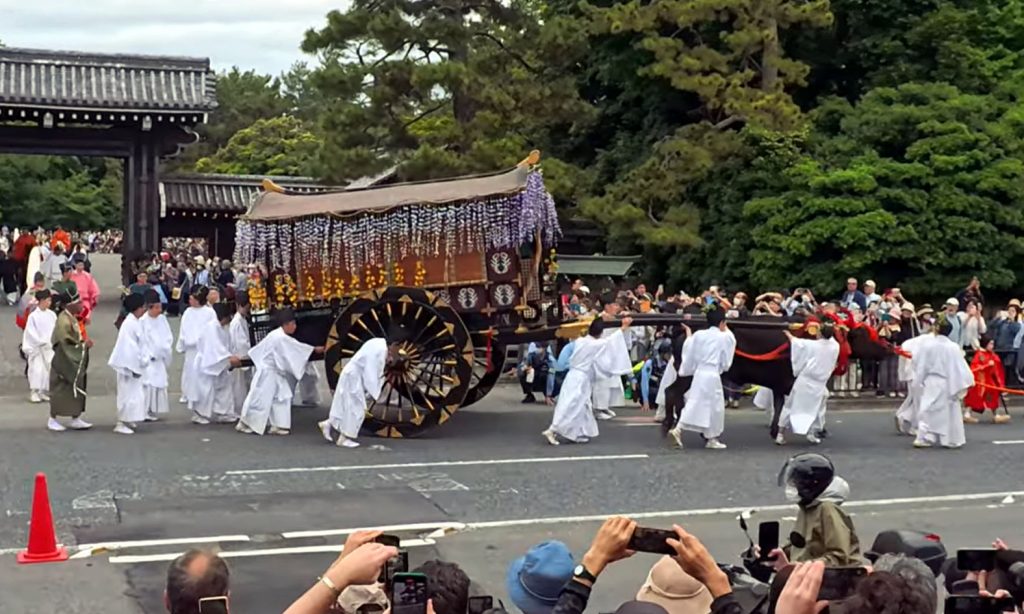
With a pleasant breeze blowing today, May 15th, the Aoi Matsuri, an annual festival of the Shimogamo Shrine and Kamigamo Shrine, was held. The Aoi Matsuri, along with the Gion Matsuri and the Jidai Matsuri, is one of the three major festivals of Kyoto. Officially known as the “Kamo Matsuri,” the Aoi Matsuri is characterized by a procession featuring Heian-era court nobles adorned with hollyhock leaves. The procession moves from the Kyoto Imperial Palace through Shimogamo Shrine to Kamigamo Shrine. The procession, including the palanquin of the Saio-dai (a woman chosen to represent the ancient imperial princesses who served at the shrine), consists of over 500 people and stretches over a kilometer. Approximately 35,000 people, as reported by the police, gathered along the route to catch a glimpse of the elegant Heian scroll-like parade and to take photos.
The origins of the Aoi Matsuri date back more than 1,500 years. During the reign of Emperor Kinmei, a poor harvest and ensuing famine and epidemics prompted the emperor to send imperial envoys to conduct rituals to honor the “Kami of Kamo.” This marked the beginning of the festival, which, being a court event, was carried out primarily by the nobility, thereby preserving a strong aristocratic tradition. In the Heian period, the Aoi Matsuri was synonymous with festivals, being a highly prestigious ceremony referred to as the “Kamo Matsuri.” However, during the Edo period, the ox carts and imperial envoys’ garments were entirely decorated with hollyhock leaves, leading to the festival being commonly known as the “Aoi Matsuri.”
The Aoi Matsuri includes preliminary rituals, starting with the Yabusame (horseback archery) ceremony at Shimogamo Shrine (located in Sakyo-ku, Kyoto) on May 3rd. This is followed by the Saio-dai Misogi (purification ceremony) on May 4th, the Busha (archery) ceremony on May 5th, the Mikage Matsuri on May 12th to welcome the deities, culminating in the Aoi Matsuri on May 15th.
薫風が心地良い今日5月15日、下鴨神社と上賀茂神社の例祭である葵祭が行われました。葵祭と祇園祭、時代祭の三つを「京都三大祭」といいます。正式には「賀茂祭(かもさい)」といわれる葵祭は、平安時代の優雅な王朝装束に葵の葉を飾った行列で知られています。行列は京都御所から下鴨神社を経て上賀茂神社へと向かいます。斎王代(さいおうだい)の腰輿(およよ)を含む行列は総勢500人を超え、長さは1キロにも及びます。沿道には優雅な平安絵巻を一目見ようと、警察発表でおよそ3万5000人が押しかけ、写真におさめるなどして楽しんでいました。
葵祭の始まりはなんと1500年以上前にさかのぼります。欽明天皇の時代に凶作に見舞われ飢餓疫病が流行したため、天皇が勅使をつかわし「賀茂の神」の祭礼を行ったのが起源で、朝廷の行事として貴族中心にすすめてきたことから、貴族の伝統が色濃く残るお祭りでもあります。平安時代には祭りといえば葵祭をさすほど格式高い祭礼で、当時は「賀茂祭」と呼ばれていましたが、江戸時代に牛車や勅使の衣冠をすべて葵の葉で飾るようになり「葵祭」と呼ばれるようになったそうです。
葵祭には前儀があって、5月3日に下鴨神社(京都市左京区)で行われる流鏑馬(やぶさめ)神事に始まり、4日の斎王代御禊(さいおうだいみそぎ)の儀、5日の歩射(ぶしゃ)神事、12日に神霊を迎える御蔭(みかげ)祭と続き、15日の葵祭を迎えます。
